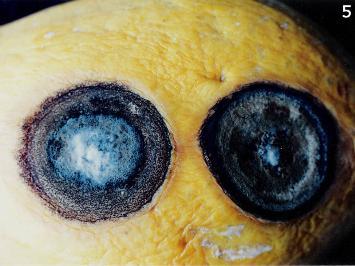

Ripe fruit rots
Several fungal pathogens are involved in fruit decay. They include Colletotrichum gloeosporioides (Glomorella cingulata), Alternaria tenuis, Phomopsis caricae-papayae and Ascochyta caricae.
Symptoms first appear as brown, superficial discolourations of the skin. These develop into circular, more or less sunken spots and tend to occur in a group on the outer exposed side of the fruit and often join to form a large rotted area extending deep into the flesh. The fungi causing ripe fruit rots live on dying leaf stalks and produce spores, which spread to the fruit particularly during wet weather.
Several of these fungi, especially, Colletotrichum gloeosporioides, may infect green fruit and remain dormant in the tissues until ripening when they develop rapidly. They constitute a big post-harvest problem especially during transport and storage.
- A 20-minute hot-water dip at 45 °C reduces post-harvest decay.
- Spray fruit with hot water at 54 °C for 3 minutes.
- Destroy rotten fruit.
- Practise early harvesting.
